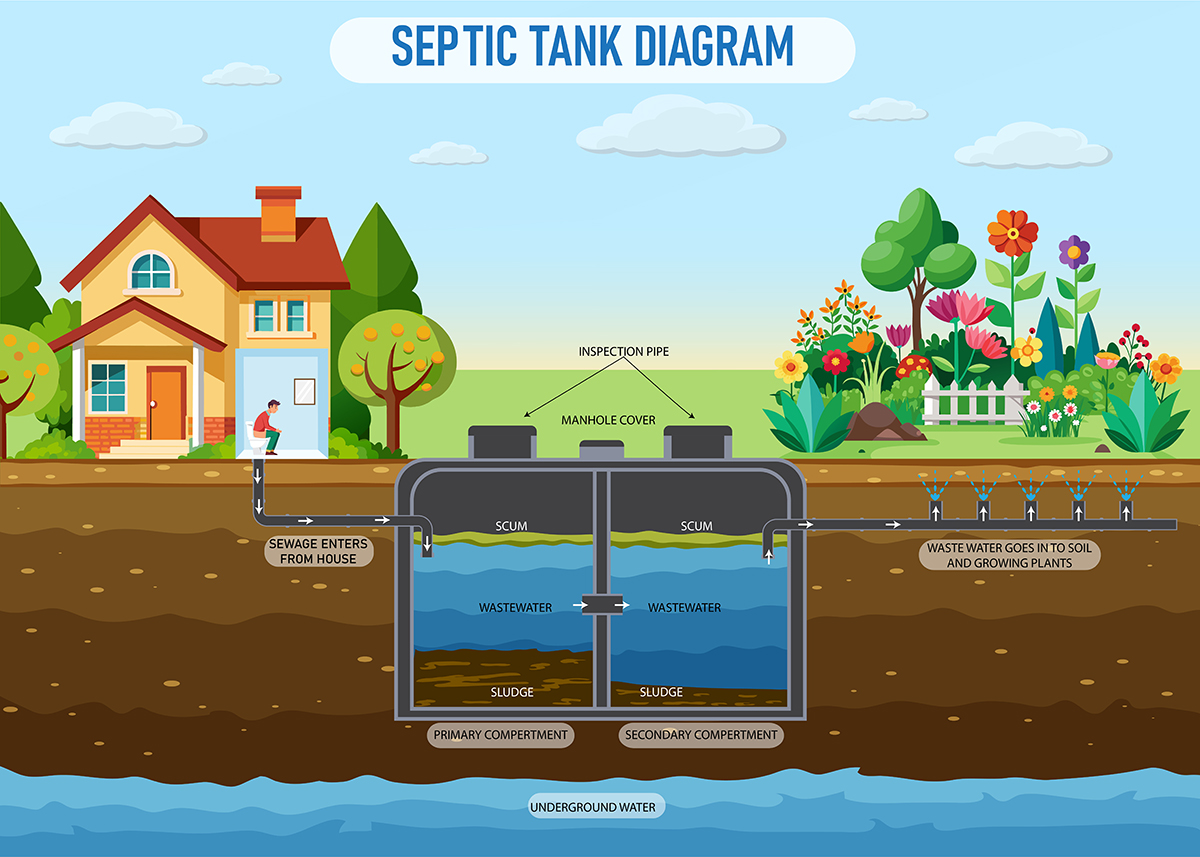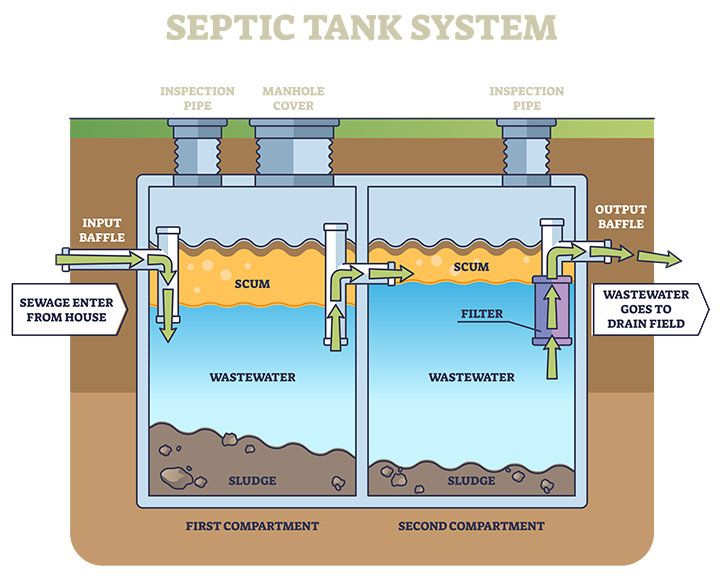Septic Tank System FAQs
WHAT EVERYONE SHOULD KNOW ABOUT SEPTIC TANK SYSTEMS
THE HOUSEHOLD PLUMBING AND WASTE SYSTEM
If you are like most people, you know very little about your septic tank system. This is understandable. In urban and suburban areas there are sewers to carry household waste to muncipal wastewater treatment facilites.
In more rural areas, however, septic tank systems provide the functions of both sewers and treatment facilities.
All household waste is disposed of through the septic system. The proper operation of the septic system is essential to public and private health, to property values, and to the environment. To see if you know enough about your septic system, answer the following questions. If you cannot answer all the questions, your septic system could become a huge aggravation, public nuisance, health hazard and financial burden.
- Do you know what a septic tank is and how it works?
- Do you know what kind of soil absorption area you have and how it works?
- Do you know what causes septic systems to fail?
- Do you know what it costs to replace a failed septic system?
- Do you know how to keep a septic system from failing?
- Do you know that failed and failing septic systems contribute to pollution?
These are very serious questions. The health of your family and the value of your property rely heavily upon the answers to these questions. "An ounce of prevention is worth a pound of cure" was never more true than it is with septic tank care. A small commitment to the care of your septic system will protect you indefinitely from the nightmare created by a failing system. This pamphlet will attempt to give you a clear picture of how household waste is treated from drain line to soil.
The quantity and composition of waste generated in the home varies according to the number of residents, their personal water usage, and the water-utilizing appliances in the home.
The septic tank system is a small on-site sewage treatment and disposal system buried in the ground. The septic system has two essential parts:
- the septic tank and
- the soil absorption area.

The Septic Tank
The septic tank was patented in London around 1900. Webster's dictionary defines the septic tank as "a tank in which waste matter is decomposed through bacterial action." The modern septic tank is a watertight box usually made of precast concrete, concrete blocks, or reinforced fiberglass. When household waste enters the septic tank several things occur:
- Organic solid material floats to the surface and forms a layer of what is commonly called "scum". Bacteria in the septic tank biologically convert this material to liquid.
- Inorganic or inert solid materials and the by-products of bacterical digestion sink to the bottom of the tank and form a layer commonly known as "sludge".
- Only clear water should exist between the scum and sludge layers. It is this clear water-and only this clear water-that should overflow into the soil absorption area.
Solid material overflowing into the soil absorption area should be avoided at all costs. It is this solids overflow that clogs soil pores and causes systems to fail. Two main factors cause solid material to build up enough to overflow:
- bacterial deficiency, and
- lack of sludge removal.
Bacteria MUST BE PRESENT in the septic tank to break down and digest the organic solids. Normal household waste provides enough bacteria to digest the solid UNLESS any harm is done to the bacteria. Bacteria are very sensitive to environmental changes. Check the labels of products you normally use in the home. Products carrying harsh warnings such as "HARMFUL OR FATAL IF SWALLOWED" will harm bacteria. The following commonly-used home care products - even when used according to directions - can reduce the bacteria population required for proper septic tank operations:
- detergents - bleaches - cleaning compounds disinfectants - acids - sink & tub cleaners
- toilet cleaners - polishes - caustic drain openers
People rarely think of the effect of these products on the septic tank system when the products go down the drain. What kind of effect do you think anti-septics have on your septic tank? Bacteria must be present to digest the scum. If not digested, the scum will accumulate until it overflows, clogging the soil absorption area.
The sludge in the septic tank - inorganic and inert material - is not biodegradable and will not decompose. If not removed, the sludge will accumulate until it eventually overflows, again clogging the soil absorption area.

- detergents - bleaches - cleaning compounds disinfectants - acids - sink & tub cleaners
- toilet cleaners - polishes - caustic drain openers
People rarely think of the effect of these products on the septic tank system when the products go down the drain. What kind of effect do you think anti-septics have on your septic tank? Bacteria must be present to digest the scum. If not digested, the scum will accumulate until it overflows, clogging the soil absorption area.
The sludge in the septic tank - inorganic and inert material - is not biodegradable and will not decompose. If not removed, the sludge will accumulate until it eventually overflows, again clogging the soil absorption area.
Drainage pits - also called drywalls or cesspools - are made of precast concrete or concrete block. They are cyclinders with closed tops, open bottoms, and holes in the sidewalls. Some older systems consist of only a drainage pit or cesspool.
Solids accumulating on the interior surfaces of the pit or in the soil will again contribute to sluggish drainage or failure.
SEPTIC SYSTEM MAINTENANCE
The U.S. Government Department of Health, Education, and Welfare Public Health Service says, "A septic tank system will serve a home satisfactorily only if it is properly designed, installed, and adequately maintained. Even a good system which does not have proper care and attention may become a nuisance, and burdernsome expense". Septic system maintenance means two simple things. First, sludge that accumulates in the bottom of the tank must be pumped out periodically. How frequently depends on the size of the tank, the use it gets, and the condition of the system. There is no additive that you can put in the tank that will deal with the sludge. IT MUST BE PUMPED OUT. If not pumped out, the sludge will eventually overflow into the soil absoprtion area. This will clog the system, and it will need to be replaced, at enormous expense and inconvenience. The second part of septic system maintenance involves the bacteria necessary for solids digestion. If bacteria-killing products are used in the home - as they usually are - the bacteria should be replenished. If the bacteria level is too low, the solids may not be digested properly. Then solids can build up too much and overflow into the soil absorption area. This again can clog the system, requiring major repair of replacement. Your septic tank could be overflowing solid material RIGHT NOW, and you won't know it until it blocks the soil absorption system so badly that no more drainage is possible. This blockage takes varying lengths of time. But it is fact: a neglected system WILL get blocked; It WILL overflow; it WILL have an obnoxious odor; it WILL contaminate and pollute. It may also require repair or even replacement. The first septic system "emergency" - a backup or overflow - often marks the beginning of a failing trend. Replacement costs vary, but they can be very, very expensive - especially if contaminated material needs to be removed.
DO NOT NEGLECT YOUR SEPTIC SYSTEM
Your professional septic contractor can inspect the condition of your system. He can tell you which specific type of soil absorption system you have. If the tank needs to be cleaned, he is equipped to clean it. If there is evidence of bacterial deficiency - such as overly thick scum or solids buildup inside the tank - he can supply you with ccls liquid bacteria/enzyme septic system treatment. ccls contains enzymes immediately available to break down solids buildup in drains, pipes, septic tank, and soil absorption system. ccls also contains reproductive bacteria for continued aid in solids digestion and settling, suspended solids removal, and odor control. Regular septic system maintenance combined with water conservation should give you many years of trouble-free use. If not maintained, your septic system may fail, requiring excavation and repair or replacement. You will have to endure the expense of this work, as well as the aggravation of trucks and equipment on your property and the disruption to your yard. Which makes more sense to you? Would you drive your car 100,000 miles without an oil change?
Your septic system should last a very long time if properly designed, installed, and maintained. Neglected systems WILL FAIL. Isn't it time to start your program of regular pumping and ccls? The well-being of your family and your property value are at stake.PROTECT THEM - DON'T NEGLECT THEM!

SOME COMMONLY ASKED QUESTIONS & ANSWERS
Q. What causes the thick crust in my tank?
A. The crust is the organic material that has congealed into a solid mass. This condition can indicate a bacterical deficiency. Ask your contractor if your tank needs pumping and ccls to avoid future problems.
Q. I had my tank pumped out last week. Is it possible that it's full already?
A. Not only is it possible, it's necessary. Septic tanks are designed to operate full for proper water/solids separation.
Q. Is there anything I can put in my tank to avoid pumping?
A. No. Some of the material in the tank is not biodegradable. This material must be pumped out.
Q. My system backed up recently for the first time in many years. Why should I start maintaining now?
A. Even though the backup may have been caused by broken pipes, tree roots intruding into your lines, or some other obstruction, it is also possible that this backup is the first sign of system failure. Call your contractor to discuss your system.
Q. The drainage in my house seems to be sluggish and sometimes temporarily backs up. I also sometimes have a foul odor and mushy ground in my backyard. Are these signs of septic system failure?
A. These may or may not be signs of a deteriorating septic system. Contact your contractor to discuss these problems.
IMPORTANT HINTS FOR A HEALTHY SEPTIC SYSTEM
- Do not overload your septic system.
- Use water sparingly.
- Do only full laundry and dishwasher loads at off-peak times if possible.
- Do not put kitchen grease down the drain.
- Do not flush cigarettes, sanitary napkins, disposable diapers, or other inorganic materials down the toilet.
- Do not put gasoline, oil, anti-freeze, paint, paint thinner, pesticides, etc., down the drain. Use garbage disposal sparingly or increase septic system maintenance schedule.
- Check all plumbing fixtures for leaks.
- Ask your contractor if you think that roots are clogging your pipes.
- Water softener use requires increased septic system maintenance schedule.
RECOMMENDED DOSAGES
For Septic Tanks and Cesspools: Apply at least 2 oz. ccls weekly in toilet bowl.
For Drains and Pipes: Apply 2 oz. ccls weekly to avoid buildup and odor.
Safe for Garbage Disposals: Apply 2 oz. ccls weekly directly to disposal to avoid buildup and odor.
Older or Overtaxed Systems: Consult your contractor for proper dosage for your system.
OTHER USES OF ccl
ccls will remove most pet stains and odors from carpets and other areas.
ccls will remove food stains from most carpets and other fabrics.
ccls can be used as a laundry presoak for food and urine/fecal stains.
Keep ccls in a spray bottle for odor control in garbage can, diaper pail, cat litter box, etc



